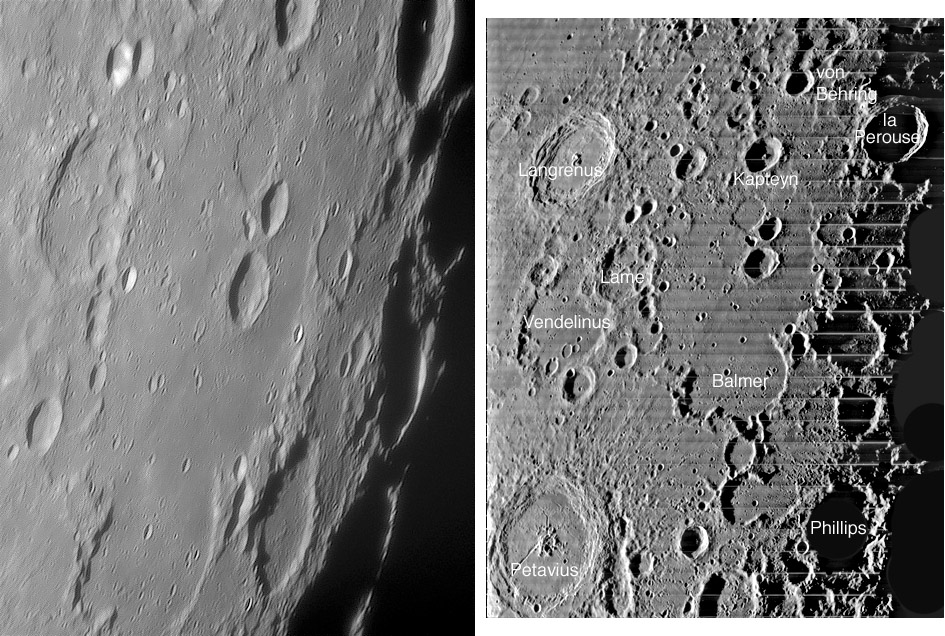left image by Bob Pilz and right from Lunar Orbiter IV USGS Lunar Digitization Project
Bob comments that he imaged this non-descript area, because I was surprised to see such a relatively smooth area this large in this part of the moon. It looks like it might be a very large old lava flooded crater… He is right - it's the middle of the ancient Balmer Basin! As I researched this LPOD I discovered that Bill Hartmann and I in 1971 apparently were the first to recognize that this was an ancient basin. Others have studied it thoroughly, most recently, Ray Hawke and colleagues. On the Lunar Orbiter IV image the ~210 km diameter inner rim of the basin is marked by a scraggly arc of hills that curves from Balmer to Kapteyn over to Lame. The area interior to this residual rim is all light-hued smooth plains. The outer rim (450 km) is harder to see but extends from Phillips along the right edge of the image to la Perouse, up to von Behring, across to the eastern edge of Langrenus, through Vendelinus, and is lost under the ejecta of Petavius. This feature was was first suspected to be a basin because it has a small mascon, and Apollo data suggested it was higher in Mg, Th and Fe, characteristics of mare basalts. But it is not dark. In 1979 Pete Schultz and Paul Spudis discovered a number of dark halo craters (DHC) and proposed that there were dark mare lavas under a veneer of highlands debris ejected from nearby craters. Hawke and others confirmed all these proposals using Clementine and Lunar Prospector data. A Clementine image reveals that a conspicuous DHC occurs northeast of Petavius and many small ones are in the southern part of the basin - Hawke’s group found 25 in all. So Bob was right. The smooth area east of Lame is unusual - it is a basin too old and battered to be detected except for the remote sensing eyes of lunar orbiters. How many other basins are slighly older and more deeply covered by ejecta so that we don’t suspect them? And how much more widespread are mare lavas?
Technical Details:
Left: 2006/12/06, Utime: ~06:46. 200mm f/6 Newtonian reflector, Televue 3x Barlow , DMK 21BF04 B/W camera, ‘Blue’ IR-block filter, .20 arcsec/pixel, 30 fps, 1/73 sec, 600/6000 frames stacked. Processed in Registax, ImagesPlus, PS CS. Taken from Lat: 35 degrees 36 minutes N, Long: 82 degrees 33 minutes W, Elev: ~850m
Related Links:
Rükl charts 49 & 60
Bob’s website
Yesterday's LPOD: Where is Alhazen Alpha?
Tomorrow's LPOD: The Hase-Petavius Rille
COMMENTS?
Register, Log in, and join in the comments.




